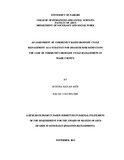| dc.description.abstract | Drought is a slow-onset, creeping natural hazard that is a normal part of climate for
virtually all regions of the world. Importantly, drought results in serious economic,
social, and environmental impacts (Wilhite, 2000). Drought onset and its end are
often difficult phenomenon to determine and so is its severity. Drought severity is
dependent not only on the duration, intensity and spatial extent of a specific drought
episode, but also on the demands made by human activities and vegetation on a
specific region’s water supply. The impacts of drought are largely non - structural and
spread over a larger geographical area than are damages from other natural hazards.
The recurrence of severe drought is a cause of human suffering and a major blockage
to pro-poor livestock development in sub-Saharan Africa, particularly in pastoral and
agro pastoral systems. In Kenya, the frequency and severity of drought has been on
the increase due to climate change. The Arid and semi-Arid Lands (ASALs),
especially Northern Kenya (Isiolo, Marsabit, Mandera and Samburu) are the most
vulnerable (Cordaid and IIRR; 2011). It is in this background that the International
Institute of Rural Reconstruction (IIRR) facilitated the documentation of regional best
practices in drought management in 2004. These culminated in a production of the
widely used Drought Cycle Management (DCM) toolkit for greater horn Africa. The
Kenya Drought Cycle Management (KDCMP) implemented between 2005-2007 by
ten agencies with the sole aim of piloting DCM concept at community levels.
This study was designed to investigate the extent to which DCM is succeeding in
mitigating against drought in Wajir county since its piloting. The study aimed at
finding out the challenges DCM is faced with at the same time establish the best
2
practices in the DCM project. The specific objectives of the study were to establish
the various strategies used in community managed disaster risk reduction on drought;
to evaluate the appropriateness of CDCM to the people of Wajir county; to establish
the level of acceptance of the program by the people of Wajir County and to establish
the social and economic gains that come with the adoption of the CDCM.
The main theories that guided this study were the Bordieu's theory of cultural, social,
and symbolic capital within a community and the Community empowerment model.
The study used a purely descriptive design in which members of all the ten groups in
the pilot participating in the CDCM were interviewed .At the same time the CDCM
program officers and the county officials was interviewed as key informants.
All the household heads for 10 participating households were interviewed. Among
the key findings are that of the various coping strategies used 100 percent of the
respondents opted to move their animals and families to other places in search of
pasture during drought. On the other hand 87 percent reported to have opted to sell
the weak animals in the market while 45 percent slaughtered the weak animals for
domestic consumption. It was also clear that 11 percent were of the view that CDCM
contributed greatly in meeting their economic needs, 16 percent said to some extent,
17 percent said fairly so, 28 percent had not seen any changes while 28 percent saw
none at all. On the effect of CDCM on their relations, 65 percent were of the opinion
that their participation in the CDCM programme had very much improved their
relationship, 21 percent said to some extent, 6 percent said fairly so, 7 percent had not
seen any effects and 1 percent said none at all. It is also clear that 6 percent were of
the view that their participation in the CDCM program had very much led to the
increase of their livestock, 17 percent said to some extent, 30 percent said fairly so, 33
3
percent had not seen any effect and 14 percent said none at all. Finally on rating it
came out clear that clear that 29 percent rated CDCM as the best, 9 percent rated it
as better, 12 percent rated it as fair, 30 percent said it was not any better, 20 percent
said it was the worst. | en_US |

